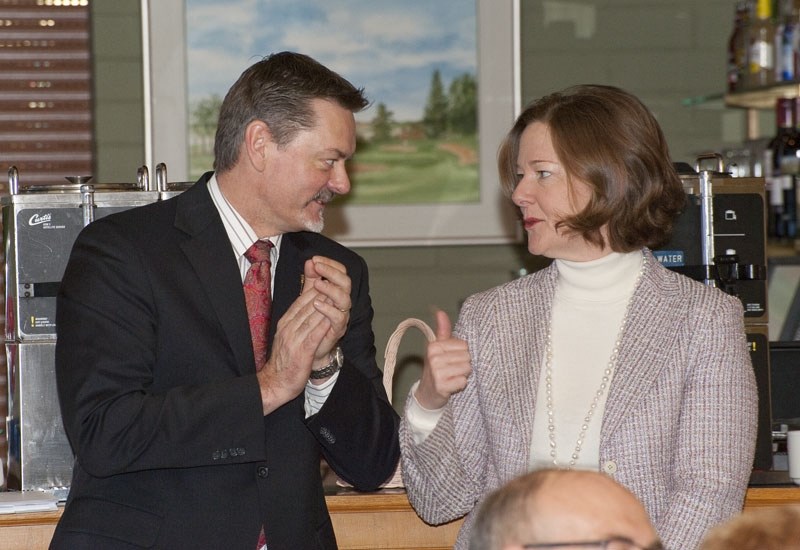The province needs to learn to live within its means, says Alberta’s finance minister, and that means saving cash and cutting fat before raising taxes.
The province needs to learn to live within its means, says Alberta’s finance minister, and that means saving cash and cutting fat before raising taxes.
Finance Minister Doug Horner spoke about the provincial budget to about 40 local residents at the Sturgeon Valley Golf & Country Club Monday. The talk was organized by the Athabasca-Sturgeon-Redwater PC Association.
Premier Alison Redford also put in a surprise appearance at the talk and answered a few questions from the audience along with Horner.
Horner tabled the 2013-2014 budget the previous week – a budget that included a new savings plan, little new spending and a $1.97 billion deficit.
The province is going to have about five million residents in 20 years at current growth rates, Horner said.
“Can you imagine having another St. Albert built right next door every year for the next 20 years?” he asked. “Imagine the number of schools we need. Imagine the number of hospitals.”
At the same time, the province took a $6.5-billion hit to its revenues this year due to low bitumen prices, Horner continued.
“You’re doing a household budget and all of a sudden 30 per cent of your income disappears,” he told the crowd. “We knew we had to do some things differently.”
Albertans told the province to get its own house in order before rooting around in taxpayers’ pockets, Horner said in an interview. That’s why the province has not brought in a sales tax in this year’s budget and why it doesn’t plan to do so in the next two either.
“We’re going to do everything in our power to make sure that we’re living within our means,” he said.
“The second thing they told us is you guys have got to start saving some money,” he told the crowd. “We want you to save it in good times and in challenging times.”
This year’s budget includes a legislated savings plan that will set aside about $297 million this year into the Heritage Trust Fund, Horner said. The province will salt away about $2.4 billion in the next three years under the proposed budget, giving it about $24.2 billion in the bank – a bit less than the $25.4 billion it had in 2011.
This is money that’s meant to help diversify the Alberta economy, Horner said in an interview, and Albertans need to decide how much of this non-renewable resource revenue they want to save.
“Norway chose to save it all,” he said, but has a high tax rate as a result. “We can do things differently.”
The budget also shows a change in how the province does business, Horner said in an interview.
The province has been paying cash for all its capital) assets, to the tune of $72 billion in the last 15 years, which doesn’t make sense given the province’s resources and low interest rates, he said.
“We should leverage the assets we have.”
This year’s budget proposes some $4.3 billion in borrowing for new infrastructure. The province will still have net assets and no net debt after three years even with this borrowing, Horner said.
The proposed budget keeps the Municipal Sustainability Initiative fund at last year’s levels ($896 million), Horner said to the crowd.
“It is our intention to get to a higher level of MSI funding in the future when we can afford it,” he said, in response to a question from St. Albert Mayor Nolan Crouse, “but today, we can’t.”
The fund would also put more emphasis on regional projects in the future, Horner said.
The budget includes no new money for salary hikes for teachers and doctors.
Alberta has some of the highest paid doctors and teachers in Canada, Horner said in response to a question from Alberta School Boards Association president Jacquie Hansen, and those wages have been running ahead of those in the private sector.
“We are taking this opportunity to do a bit of a reset,” he said, and the province hopes to hold the line on public sector wages until the private sector catches up. MLAs agreed to cut their own wages by eight per cent last year, he noted.
Alberta should have done more to promote its environmental record to the U.S. when it came to the Keystone-XL pipeline, Redford said in response to an audience question, and is now doing so in its talks with its southern neighbour.
“America needs to believe that Canadians are not skeptical about this issue,” of climate change, she said.
Two of the province’s four carbon-capture projects have been scrapped in recent months, and Alberta Environment admitted in late February that the province was falling far short of its own 2020 emission reductions target. This year’s proposed budget also cuts Alberta Environment’s budget by about $22 million.
Climate change policy spending also drops to $695,000 from last year’s $17.6 million under the budget – a reduction of about 96 per cent. This drop is due to the province reallocating federal Eco-Trust dollars from this area to capital projects, said Alberta Environment spokesperson Jessica Potter.
The provincial budget will go to a final vote toward the end of April, Horner said.
